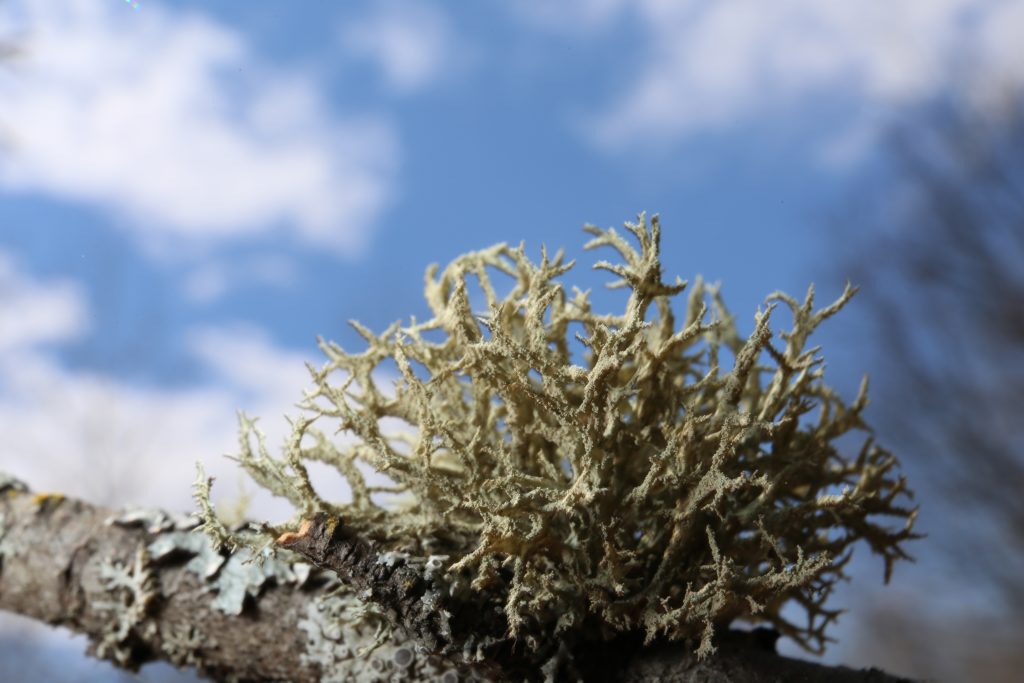Introduction to Lichens

Why lichens? These peculiar organisms made up from a fungus and an alga are not exactly the most exciting creatures on Earth. Definitely not the charismatic megafauna (large furry animals), which excite the imagination of young and old naturalists. But looking at these small living growths through a magnifying glass reveals a new miniature living world to an interested observer.
We, at the Claude Garton Herbarium (code-named LKHD), invite you on a tour of the university campus, to examine the surfaces of soil, bark or stones to discover this Liliputian world. Luckily, lichens tend to have limited commercial value to humankind, but are an essential component of the natural world. In the Boreal zone, apparently living on "thin air", they tend to colonize exposed surfaces on which few other organisms could survive. As they grow and die, they provide new organic "soil" in which other organisms can establish and thrive. If you are lucky, you will see orobatid mites grazing on them, or small seedlings and mosses co-existing within the lichen colonies. As you walk around in search of lichens, the native and introduced trees growing on campus will be also brought to your attention.
The quality of the "thin air" appears to be quite important for the establishment, growth, and well-being of lichen colonies. Little is known about the chancy process of lichen reproduction and spread. Clearly, they do disperse into new territory, establish themselves and start acquiring the needed raw materials for their growth. Carbon dioxide for photosynthesis by the algal partner is adequate, even at the meagre 0.04% (and rising!) of total gasses in the atmosphere. But where does the nitrogen needed for making proteins and nucleic acids come from? Some algal partners are able to capture gaseous nitrogen from the air (at 78% of the atmosphere quite abundant), but these cyanobacteria are known to be present in only about 10% of lichen species. Otherwise the abundant atmospheric nitrogen is not available to living creatures, including lichens. That leaves lightning strikes, volcanic activity, air pollutants and efficient recycling of pre-existing "reduced" biological nitrogen from dead organisms to support new life. In that respect some pollution may be good for lichens, but beware! Pollution also implies the presence of toxic substances such as sulfur dioxide and heavy metals. And it turns out lichens are very sensitive to these, and lichen absence is a good indicator of polluted areas.
In the 1960s, major research projects were initiated around the world, when it was recognized that industrial city centers and neighbourhoods of factories were virtual deserts in respect to lichen growth. The nickel mines and smelters in Sudbury were one of the prime sites where this was studied - and new lichen re-colonization of denuded surroundings of the Sudbury smelter is now providing evidence that remedial actions are beginning to pay off. Other forms of human activity, such as deforestation have nearly eliminated certain species of lichens requiring specialized habitats such as old growth forests.
Moisture is another requirement for lichen growth, and the fungal partner and its moisture retaining capabilities appear important to lichen existence. In your wanderings around campus, you will notice that partly shaded areas and horizontal surfaces, which retain moisture longer, tend to be favoured by lichens. The lichens are desiccation tolerant and can withstand long periods without water (even weeks in space outside the International space station!), but they only metabolize and grow when water is available. This can be for only short periods of time during the warm growing season, and clearly a contributing factor to lichens' slow growth rate of only a few millimeters per year.